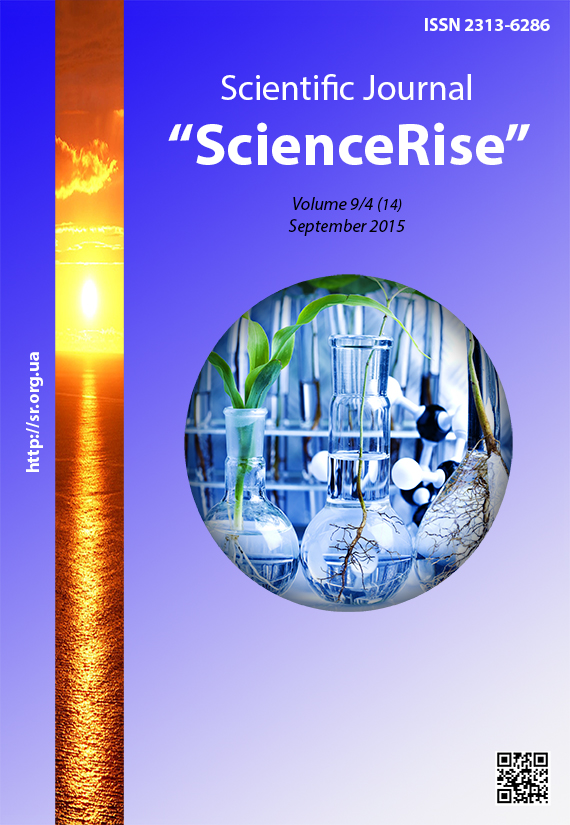Natural status of the forest biogeocenosis ecosystems in the Carpathians and its bioindication on the base of nematode complexes
DOI:
https://doi.org/10.15587/2313-8416.2015.50665Keywords:
natural status, forest ecosystems, bioindication, soil NematodaAbstract
There are soil Nematoda complexes forming in primeval ecosystems. They have the same regularities in energy consumption by the community independently of the territorial location. Additional characteristics of species diversity and structural organization of Nematoda communities exist within the realms of biogeocenosis type. It allows determining the natural status of the forest ecosystems
References
Holubets, M. A., Maryskevych, O. G., Kozlovsky, M. P. et al. (2001). Ecological situation on the north-east macro-slopes of Ukrainian Carpathians. Lviv: Polli, 162.
Genyk, Ya. V., Chernyavsky, N. V., Yashchenko, P. T. (2014). Methods of the range estimation for the forest cultures and the stage of its transformation. Bulletin of the Moscow State Forest University, 1 (100), 156–160.
Dugner, W., Fiedler, H. I. (1989). Methoden der Bodenbiologie. Stuttgart, New York: Fischer, 432.
Bolshakov, V. N., Korytin, N. S., Kryazhymskii, F. V., Shyshmaryov, V. M. (1998). A novel approach for evaluation of the biotic components of ecosystems. Ecology, 5, 339–348.
Ferris, H., Lau, S., Venette, R. (1995). Population energetics of bacterial-feeding nematodes: Respiration and metabolic rates based on CO2 production. Soil Biology and Biochemistry, 27 (3), 319–330. doi: 10.1016/0038-0717(94)00186-5
Kozlovsky, M. P. (2002). Estimation of functional organization of the soil invertebrates on the base of phytonematoda communities. Science Bulletin of Lviv University. Biology Series, 31, 146–154.
Kozlovsky, M. P. (2006). Classification of phytonematoda complexes in the primeval and secondary terrestrial ecosystems of Ukrainian Carpathians and perspectives of its practical use. Science Bulletin of Lviv University. Biology Series, 41, 54–62.
Kozlovsky, M. P. (2009). Phytonematoda of terrestrial ecosystems of the Carpathian region. Lviv: Manuscript, 316.
Kozlovsky, M. P., Bondarenko, T. V. (2013). Influence of the forest undergrowth in the hornbeam-oak forests onto the forming of the soil Nematoda communities. Science Bulletin of National Lviv Forestry University, 23.2, 15–23.
Kozlovsky, M. P., Tsaryk, I. Y. (1998). Phytonematoda complexes in the mountain pine (Pinus mugo Turra) ecosystems and its consortive relations. Ecology & Noospherology, 1 (1-2), 38–45.
Kozlovsky, M. P. (2004). Impact of hydrological regime onto the phytonematoda communities in the riverine oak forests. Science Bulletin of State Lviv Forestry University, 14.8, 373–376.
Downloads
Published
Issue
Section
License
Copyright (c) 2015 Микола Павлович Козловський

This work is licensed under a Creative Commons Attribution 4.0 International License.
Our journal abides by the Creative Commons CC BY copyright rights and permissions for open access journals.
Authors, who are published in this journal, agree to the following conditions:
1. The authors reserve the right to authorship of the work and pass the first publication right of this work to the journal under the terms of a Creative Commons CC BY, which allows others to freely distribute the published research with the obligatory reference to the authors of the original work and the first publication of the work in this journal.
2. The authors have the right to conclude separate supplement agreements that relate to non-exclusive work distribution in the form in which it has been published by the journal (for example, to upload the work to the online storage of the journal or publish it as part of a monograph), provided that the reference to the first publication of the work in this journal is included.

